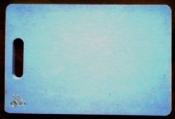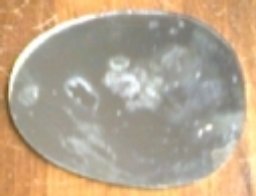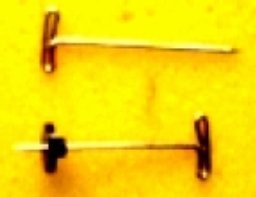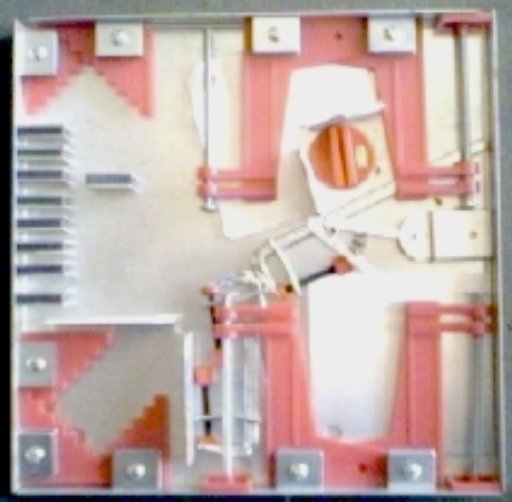Base materials for jigs will vary according to use dependent on bonding agents, fastening methods, heat and other factors including expendibility. Some will accept pins or other penetrating holding devices, while others may use tape or magnets. Several self curing mats are offered with varying qualities.
Xacto: Grid lines are very helpful, but printing does not hold up under solvent cements or Labelle 101. Some glues stick. Does not hold T-pins well. Curls in storage or with slight heat.

Note: Adjust brightness and contrast for optimum viewing.
After a few months usage.
Micro-Mark; Good cutting backup. Most glues stick. Stains very readily. Flexible and durable. Does not take or hold T-pins.

Note: Adjust brightness and contrast for optimum viewing.
After over a year usage.
Kitchen plastic cutting board: Level surface. Durable. Tends to dull knives. No T-pins.

Note: Adjust brightness and contrast for optimum viewing.
After heavy usage.
Micro-Mark soldering pad: Excellent heat resistance. Holds T-pins well but holes do not cure.. Tends to bend slightly.

Note: Adjust brightness and contrast for optimum viewing.
After some heavy soldering.
While sheets of glass can be used for gluing and cutting, they do not accept T-pins nor magnets. Float glass is far superior with an almost true flat surface. Edges should be rounded to avoid cuts. Since glass is a super cooled liquid it can sag, if a large piece is edged with tape or rimmed with metal. Using a glazed picture frame to align outside corners could suffer from this in critical cases. Also the corners may not be truly square and protrusions, on the pieces, may prevent good alignment. An old mirror can be used for trimming resin castings with single edge razor blades, gluing and placing drops of ACC for bent pin pickup. Easily cleaned with old blade.

Note: Adjust brightness and contrast for optimum viewing.
Not cleaned, showing ACC spots.
Wood can be an excellent choice, if selected carefully. While durable for cutting, true flat sheets of hard woods, clear plywood or even particle board and Masonite do not serve well for pinning and fastening. Excluding balsa, softer woods like bass, pine, spruce and holly are excellent. Balsa should be avoided for all modelrailroad projects, since it is weak, unstable and easily damaged. Normally glues in plywood and processed sheets prevents good penetration for fastening. One exception is Homosote, which holds pins or even track spikes and nails very well with reasonable durability and cost.
Holding devices will vary with the base material and application, since some projects are flat, while others are 3 dimensional. Anything; from pins, nails and screws through clanps and vises to tape, string, and rubber bands, including scraps, strips and spacers; may prove useful.
Straight pins are very handy for sewing, but pushing them into and pulling them from wood is hard on the fingers. Used extensively in building model airplanes, T-pins relieve the strain by providing a handle. Sold inexpensively by SIG in plastic boxes in several sizes by weight, a good supply is very useful. They can be placed next to parts to hold them horizontally or they can be pushed through hidden parts (UGH!) or crossed over parts, at angles to form an X, to hold them down. A better solution is to add plastic, hold down disks with tight fitting holes. Even the T top can be used as a hold down, and only curved surfaces defy their use.

Note: Adjust brightness and contrast for optimum viewing.
Small no. 16 T-pin__with hold down disk. Enlarged.
FLEXIBLE MAGNETIC JIG SYSTEM
Very often a quicky jig is necessary to hold odd things in place while fastening. The use of magnets is a time honored tradition and today with ceramic magnets in all shapes and forms things are much easier. Placing magnets on opposite sides, joints or laminations can be held securely for gluing or soldering. Using a slainless steel or iron cookie sheet or other flat sheets, magnets can be strategically located to form jigs. Plans can be placed under a clear plastic sheet or plastic wrap, stretched across pan, to shield from cement; ala balsa, stick model airplanes using waxed paper. By adding a few accessories like clamps or forms, utility can be greatly expanded. With the newer rare earth magnets very large forces can ge applied, but care must be exercised as the may crunch or break more delicate parts. The only drawback is that ceramics are very hard to cut, requiring diamond tools.

Note: Adjust brightness and contrast for optimum viewing.
Small bar clamps w/ magnetic base.
A very flexible commercially available system can serve as a basis. Somewhat resembling deeper steel cookie sheets, they are offered, in two sizes: 10.25 x 10.25 in. or 6 x 24 in. about 7/8'in depth ,with 8 ceramic magnets having steel plates on either side and a screw hole clear through. Providing a good flat surface, either side may be used.
Add ons consist of 4 hold down clamps, 5 stepped risers, a spring clamp and 3 bar clamps (2", 3 1/2" & 5") with a magnetic base. A set of precision aluminum gluing jigs with 2 each of inside, outside and flat, are shown. With additional magnets, any number of accessories can be made to fit the job.

Note: Adjust brightness and contrast for optimum viewing.
Stored accessories .
BACK TO HOLDING
BACK TO JIGS
